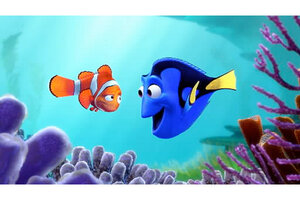Ellen DeGeneres in 'Finding Nemo 3D': Is it worth seeing in its new format?
Ellen DeGeneres' 'Finding Nemo' gets a 3D re-release – is it worth the ticket price?

Ellen DeGeneres voices forgetful fish Dory (r.) and Albert Brooks voices father fish Marlin (l.) in 'Finding Nemo.'
Reuters
Three years before Disney officially purchased Pixar Studios, the animation house released one of their most beloved and critically lauded films to date. Finding Nemo opened May 30, 2003 and delivered over $800 million in worldwide ticket sales – on a $94 million budget. Since that time, the film has become a fan-favorite home entertainment choice for families and animation fans – not to mention positioned characters like Nemo, Marlin, and Dory as long-term merchandising platforms.
Now that 3D has managed to take hold both at the box office and home theaters, Disney has been digging in the Pixar archives and rereleasing certain films with new 3D visuals – including Toy Story, Toy Story 2, and soon Monsters Inc. Given the critical and commercial success of the film, there’s no debating that the Finding Nemo story is a must see for movie fans. However, with ten years of availability on DVD (and now Blu-ray), does Finding Nemo 3D, coupled with Mark Walsh’s Toy Story short, Partysaurus Rex, offer enough payoff to make it worth another viewing - this time in 3D?
NOTE: As with previous 3D rerelease reviews, the purpose of our Finding Nemo 3D review is to help our readers make an informed decision about the 3D rerelease, not spend time revisiting any overarching problems that might have been evident in the original movie – since readers are likely well acquainted with the quality and overwhelmingly positive critical reception of the 2003 film. In a time when movie studios are quick to shove unnecessary post-conversion rereleases into theaters, moviegoers need to know which movies have enjoyed a rigorous as well as artistic 3D treatment and which ones are simply revisited for the purpose of studio double-dipping – made even more enticing by 3D upcharges and eventual 3D blu-ray sales.
Fortunately, while Disney is sure to net a solid return on their 3D investment, Pixar’s 3D conversion process is much more involved than typical “post-conversions” (the Pixar 3D team likens it more to “recreation”) – resulting in an experience that is absolutely enhanced by the added depth. Unlike film conversions, Pixar can actually revisit the original digital Finding Nemo files and, as they convert each scene into 3D, are able to manually address glitches or areas of discomfort that might occur as a result of moving the images from a 2D to 3D plane. In some cases the 3D team even fixed problems that slipped through the cracks the first time the film was released – details that will no doubt be the subject of a special feature on the inevitable 3D Blu-ray.
Anyone who is immediately put off by the idea of the conversion team fiddling with the original movie can rest easy – the changes represent only minor cosmetic alterations (removing elements that might be distracting in a 3D foreground) or addressing oversights that slipped through in the original version (fixing a stationary shadow that didn’t move after a character exited the shot). The film doesn’t contain any new scenes, extended takes, or new easter eggs – it’s the same Finding Nemo, except optimized for 3D viewing.
In general, the Pixar conversion approach is in line with 3D guru James Cameron – who keeps the audience’s emotional focus at the screen and enhances the experience with subtle elements positioned in the foreground or background. Prioritizing immersion over gimmicky projectiles, might be underwhelming for audience members who routinely “test” 3D by removing their glasses (a very limited measure in the first place) but the colorful and vibrant Finding Nemo setting should provide discerning moviegoers with plenty of fan-favorite moments that are successfully enhanced by the added dimension. On their own, few of the scenes are likely to offer outright memorable 3D visual set pieces (this is still a post-conversion); however, as an overall experience, viewers should notice a stronger association with the underwater environment as well as a number of shots that are especially striking this round – thanks to the added dimension (i.e. the Jellyfish forest and East Australian Current).
Additionally, the Toy Story short, Partysaurus Rex, from director Mark Walsh is paired with Finding Nemo 3D and is easily the most enjoyable franchise spin-off to date. The short film follows Wallace Shawn’s beloved dinosaur character, as the typical “party pooper” of the group attempts to, instead, become the life of a bathtub (foam) party. Considering its abbreviated short film runtime, Partysaurus Rex alone wouldn’t be enough reason to pay for a subpar 3D rerelease but, attached to a well-crafted offering like Finding Nemo 3D, the toon serves as an exceptionally entertaining lead-in. While Toy Story 3 put a smart end cap on the feature franchise, the short spin-offs continue to deliver worthwhile adventures with Buzz, Woody, and the gang (especially if Pixar never attempts a Toy Story 4).
Finding Nemo 3D is a quality post-conversion experience that successfully enhances the 2003 film’s original standout visuals. While it might not offer the eye-popping gimmickry some moviegoers crave in 3D features, it’s easy to recommend the rerelease to fans who count Finding Nemo among their favorite animated features as well as anyone (young or old) who has never experienced the film in theaters. Finding Nemo 3D is another example of post-conversion done right and, paired with the especially humorous Partysaurus Rex short, is well worth another trip to your local box office.
Ben Kendrick blogs at Screen Rant.

